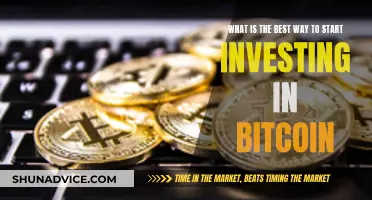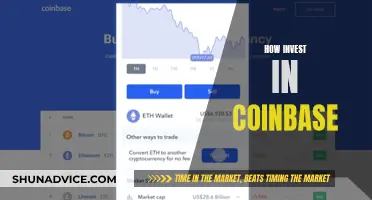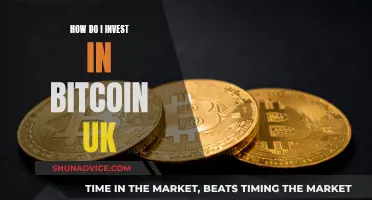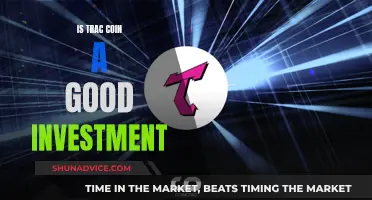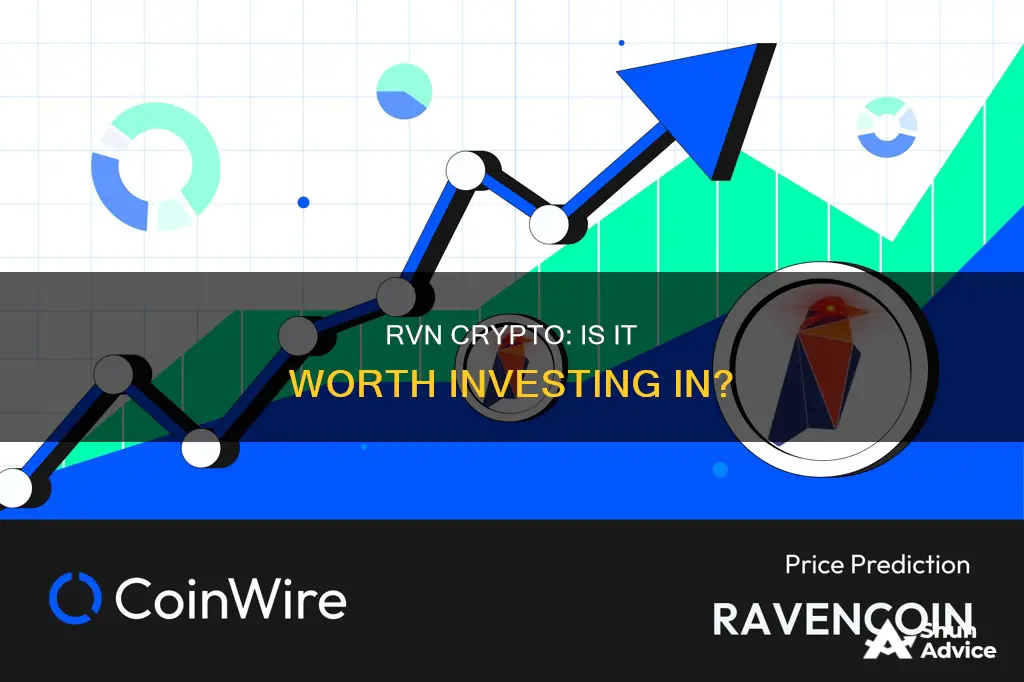
Ravencoin (RVN) is a peer-to-peer digital currency that runs on a decentralised, open-source blockchain. It is a hard fork of Bitcoin, with a focus on transferring assets from one party to another. Unlike Bitcoin, Ravencoin serves to transfer the ownership of assets, with each transmitted object represented by an unmarked token created by a user of the platform. With a market cap of under $1 billion, some consider it to be Bitcoin 3.0. In this introduction, we will explore the pros and cons of investing in Ravencoin.
What You'll Learn

Low fees and a growing mining community
Ravencoin (RVN) is a digital peer-to-peer (P2P) network that was launched in 2018. It is a fork of the Bitcoin code and was created to solve the problem of assets transfer and trading over blockchain.
One of the biggest reasons to invest in Ravencoin is its low fees and growing mining community. When compared to Ethereum, Ravencoin has exceptionally low fees. As the demand for Ethereum grew, the gas fees to use the network became prohibitively expensive for many users. This has caused some Ethereum users to look for other options, with Ravencoin being a likely alternative.
The high fees on the Ethereum network have also caused some miners to look for other coins to mine, with many finding RVN to be a very profitable option. This is because Ravencoin is a fully developed and functional blockchain, unlike Ethereum, which is constantly undergoing massive transformations. This makes Ravencoin a less risky bet than Ethereum.
The low fees and growing mining community will only strengthen Ravencoin and further its adoption. This is extremely bullish and is one of the many reasons why some people have chosen to invest in Ravencoin.
American Eagle Coins: Smart Investment or Not?
You may want to see also

Fully developed and functional blockchain
Ravencoin is a fully developed and functional blockchain. It is a peer-to-peer blockchain that facilitates the efficient creation and transfer of assets from one party to another. It is a fork of the Bitcoin code, which allows for the issuance of tokens on the Ravencoin blockchain. These tokens can have various properties, such as being limited in quantity, named, or issued as securities or collectibles. The Ravencoin blockchain is designed to be ""asset-aware", allowing anyone to issue tokens and digital assets.
Ravencoin's design is similar to Bitcoin, but with some key changes. Firstly, the block reward is 5,000 RVN, compared to 6.25 BTC for Bitcoin. Secondly, the block time is 1 minute for Ravencoin, whereas it is 10 minutes for Bitcoin. Thirdly, the total coin supply for Ravencoin is 21 billion, a significant increase from Bitcoin's 21 million. Additionally, Ravencoin uses a new mining algorithm, KAWPOW, which is designed to allow for more decentralised mining.
The Ravencoin blockchain has several use cases. It can be used to issue tokens that represent real-world assets, such as gold, shares of stock, virtual goods, rewards, and various other asset types. For example, a digital securities company, Chainstone Labs, issued 12.4 million digital shares on the Ravencoin blockchain in 2018. Non-fungible tokens (NFTs) can also be created on Ravencoin using an RVN wallet platform called MangoFarmAssets. Additionally, a tokenized version of RVN is available on the Binance Smart Chain (BSC) and can be used for borrowing, lending, and trading in decentralised finance (DeFi) applications.
Ravencoin's unique infrastructure as a Bitcoin-based network with the ability to launch and trade tokens makes it an attractive option for enterprises and industries that need to launch a digital token primarily for asset transfer. Its decentralisation-friendly consensus mechanism and security model are also advantages that Ravencoin highlights over other platforms.
The Ultimate Guide to Investing in Bitcoin Without Capital
You may want to see also

Not at risk of being classified as a security
Ravencoin (RVN) is a digital peer-to-peer (P2P) network that was built on a fork of the Bitcoin code. It was launched in 2017 and its ICO was organised on 3 January 2018. The project was founded by Bruce Fenton, Tron Black and Joel Weight, who were all seasoned businessmen and developers before starting the Ravencoin project. Fenton, for example, was an executive director of the Bitcoin Foundation from 2015 to 2018 and vice president of Morgan Stanley in the 90s.
One of the key arguments for why Ravencoin is not at risk of being classified as a security is the fact that it is a decentralised project. Another key argument is that Ravencoin was fairly launched. This means there was:
> NO: founder or developer set aside, NO: fundraising of any kind, NO: corporate structure, foundation or any official leadership, ALL: coins issued by POW (proof of work) mining.
Ravencoin's decentralised nature and its commitment to a fair launch mean that no single individual or organisation will be able to gain enough hash power to attempt a 51% attack or create any sort of artificial market price shocks.
In addition, a legal opinion on why Ravencoin is not a security was prepared in 2018 by Douglas J. Pepe of Joseph Hage Aaronson LLC.
Best Cryptocurrencies to Invest: Top Picks for 2023
You may want to see also

Industry relationships will help accelerate adoption
The idea of Ravencoin originated with Bruce Fenton, Tron Black, and Patrick Byrne. Patrick is the founder and ex-CEO of Overstock, and Tron Black was, at the time, with Medici, a subsidiary of Overstock. Tron Black became the lead developer for Ravencoin, with the support of Overstock's development resources.
Ravencoin is in an enviable position due to its ties to Overstock and Medici, as well as other entities like tZero, Watchdog Capital, and Realio. These relationships will likely result in the accelerated adoption of Ravencoin as one of the top cryptocurrencies for handling assets.
The people behind Ravencoin are extremely smart visionaries with a broad and well-rounded understanding of blockchain technology, securities laws, and free markets. They understood the importance of developing technology within the confines of existing regulations, which has positioned Ravencoin ahead of its competition.
The relationships and expertise of the founders will be key to the success of Ravencoin. The more individuals in related industries that Ravencoin can connect with, the more likely it is to be adopted, which is critical to the success of a cryptocurrency.
Bruce Fenton
Bruce Fenton is well-known in the crypto world as a board member and executive director of the Bitcoin Foundation from 2015 to 2018. Before that, he had a solid career in investment banking as the vice president of Morgan Stanley in the 90s and a managing director of Atlantis Consulting for 13 years. Currently, he works as a managing director of Chainstone Labs, a stealth fintech startup.
Tron Black
Tron Black is a principal software developer with over 30 years of experience, including leading several software companies as CEO. He has been working in crypto since 2013 on ventures including Verified Wallet, CoinCPA, and t0. Tron Black is currently employed by Medici Ventures.
Patrick Byrne
Patrick Byrne is the founder and ex-CEO of Overstock.com, a well-known online retailer. He also has experience in blockchain technology through his involvement with Medici Ventures, where he held roles as COO and CTO.
Joel Weight
Joel Weight is the CTO at Overstock.com. He started his career as a software developer after graduating from the University of Utah in 1998, right in the middle of the dotcom bubble.
A Strong Team for a Strong Project
Ravencoin is a blockchain-based protocol that allows developers and users to create tokens for any asset they like. It is a fork of Bitcoin's original code, with a focus on improving reliability, anonymity, confidentiality, publicity, and open access, among other things.
The project has a unique value proposition, and its development team is constantly working on node modernization to improve the system. Due to its strong fundamentals and the expertise of its founders, Ravencoin has the potential to be widely adopted and succeed as a cryptocurrency.
Bitcoin Investment: Good or Bad Idea?
You may want to see also

RVN is a classic digital currency
The project was launched in 2017, and the Ravencoin ICO was organized on 3 January 2018. Today, it is the 41st cryptocurrency in the Top 100, and the development team is constantly working on node modernization to improve the system. Due to the unique idea underlying the project, RVN is highly valued in the crypto community, which positively affects the price.
RVN is a digital peer-to-peer (P2P) network that aims to implement a use case-specific blockchain, designed to efficiently handle one specific function: the transfer of assets from one party to another. Built on a fork of the Bitcoin code, Ravencoin was announced on 31 October 2017 and released binaries for mining on 3 January 2018 with what is called a fair launch: no premine, ICO, or masternodes.
Ravencoin features four key changes from Bitcoin: a modified issuance schedule (with a block reward of 5,000 RVN), block time reduced to one minute, a coin supply capped at 21 billion (a thousand times more than BTC), and a mining algorithm (KAWPOW) intended to mitigate the centralization of mining caused by ASIC hardware.
RVN coins are designed as the internal currency within the network and must be burnt to issue token assets on the Ravenchain. The assets can represent anything: real-world custodial objects like gold or physical euros, virtual goods and objects, a share of a project like stocks and securities, airline miles, or an hour of someone's wage, etc.
Small Bitcoin Investments: Worth the Risk?
You may want to see also
Frequently asked questions
Ravencoin is a blockchain-based protocol that allows developers and users to create tokens for any asset they like. It is a fork of Bitcoin's original code and was launched in 2018.
Ravencoin has a number of advantages over Bitcoin, including lower fees and a growing mining community. It is also a fully developed and functional blockchain, and is not at risk of being classified as a security.
Cryptocurrency investing is extremely risky. Ravencoin is in the early stages of adoption and has a small market cap compared to other cryptocurrencies. It is also subject to the same volatility and regulatory risks as other cryptocurrencies.


